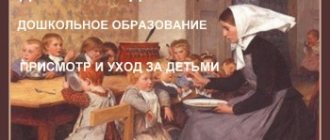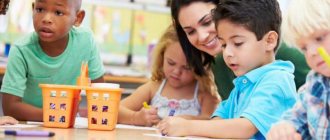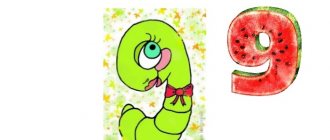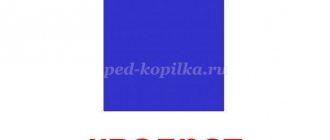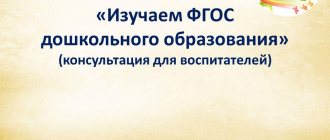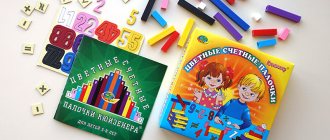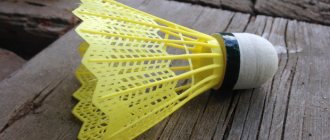Mathematical development of preschool children in the context of the Federal State Educational Standard (FSES) Consultation on mathematics on the topic
Mathematical development of preschool children in the context of Federal State Educational Standards for Preschool Education
“The further path of mathematical development and the success of a child’s advancement in this area of knowledge largely depend on how elementary mathematical concepts are laid down.”
L.A. Wenger
One of the most important tasks in raising a preschool child is the development of his mind, the formation of such thinking skills and abilities that make it easy to learn new things.
For the modern educational system, the problem of mental education (and the development of cognitive activity is one of the tasks of mental education) is extremely important and relevant. It is so important to learn to think creatively, outside the box, and to independently find the right solution.
It is mathematics that sharpens a child’s mind, develops flexibility of thinking, teaches logic, forms memory, attention, imagination, and speech.
The Federal State Educational Standard for Education requires making the process of mastering elementary mathematical concepts attractive, unobtrusive, and joyful.
In accordance with the Federal State Educational Standard for Preschool Education, the main goals of the mathematical development of preschool children are:
- Development of logical and mathematical ideas about the mathematical properties and relationships of objects (specific quantities, numbers, geometric figures, dependencies, patterns);
- Development of sensory, subject-effective ways of knowing mathematical properties and relationships: examination, comparison, grouping, ordering, partitioning);
- Children's mastery of experimental and research methods of learning mathematical content (experimentation, modeling, transformation);
- Development in children of logical ways of knowing mathematical properties and relationships (analysis, abstraction, negation, comparison, classification);
- Children's mastery of mathematical ways of understanding reality: counting, measurement, simple calculations;
- Development of intellectual and creative manifestations of children: resourcefulness, ingenuity, guesswork, ingenuity, desire to find non-standard solutions;
- Development of accurate, reasoned and demonstrative speech, enrichment of the child’s vocabulary;
- Development of children's initiative and activity.
Target guidelines for the formation of elementary mathematical concepts:
Oriented in quantitative, spatial and temporal relationships of the surrounding reality
Counts, calculates, measures, models
Knows mathematical terminology
Developed cognitive interests and abilities, logical thinking
Possesses basic graphic skills and abilities
Knows general techniques of mental activity (classification, comparison, generalization, etc.)
How to “awaken” a child’s cognitive interest?
Answers: novelty, unusualness, surprise, inconsistency with previous ideas.
That is, it is necessary to make learning entertaining. With entertaining learning, emotional and mental processes are intensified, forcing you to observe, compare, reason, argue, and prove the correctness of the actions performed.
The adult’s task is to maintain the child’s interest!
Today, the teacher needs to structure educational activities in kindergarten in such a way that every child is actively and enthusiastically engaged. When offering children tasks with mathematical content, it is necessary to take into account that their individual abilities and preferences will be different and therefore children’s mastery of mathematical content is of a purely individual nature.
Mastering mathematical concepts will only be effective and efficient when children do not see that they are being taught something. They think they are just playing. Unbeknownst to oneself, during game actions with game material, one counts, adds, subtracts, and solves logical problems.
The possibilities for organizing such activities are expanded provided that a developing subject-spatial environment is created in the kindergarten group. After all, a properly organized subject-spatial environment allows every child to find something to their liking, believe in their strengths and abilities, learn to interact with teachers and peers, understand and evaluate feelings and actions, and give reasons for their conclusions.
Each group should be provided with entertaining material, namely card files with a selection of mathematical riddles, funny poems, mathematical proverbs and sayings, counting rhymes, logical problems, joke problems, and mathematical fairy tales. Entertaining in content, aimed at developing attention, memory, and imagination, these materials stimulate children's display of cognitive interest. Naturally, success can be ensured under the condition of personality-oriented interaction between the child and adults and other children.
Particular attention is paid to the richness of the environment - the educational space must be equipped with teaching and educational means (including technical ones).
For 1st junior group
It is recommended that the sensory development center have a variety of didactic and visual materials:
Didactic games on color, shape, size, development of tactile sensations;
Educational games - Dienesh blocks, Cuisenaire sticks, Montessori frames, etc., with teaching aids for them (albums, instructions, etc.);
Attributes and materials for playing with sand and water;
Visual material on sensory education;
Board and printed games;
"Wonderful bag";
A card index of artistic words for introducing children to sensory standards.
Helper devices: magnifying glass, hourglass, magnets, measuring spoons, rubber bulbs of different sizes
For children 3-4 years old
The center of entertaining mathematics can include didactic toys and board games that develop children’s skills:
compare objects according to various criteria - size, shape, color, purpose, etc.;
group objects based on common characteristics (this is dishes, these are shoes; ribbons are the same length and the same color); compose a whole image from 6-8 parts (“Toys”, “Animals”, “Flowers”): lotto (dishes, clothes, furniture, animals, plants);
make rows of identical objects in descending or ascending order of one or another characteristic: volume, height, color intensity, etc.;
real objects: games “Freeze”, “Magic Pictures”, “Invent It Yourself”, etc.;
Didactic games: “Loto”, paired pictures, large and medium plastic mosaics, for example: “Geometric Shapes”, puzzles from 6 to 18 parts, sets of cut pictures on cubes, pictures - stencils: “Fold the flower”, “Fold the Christmas tree”, “Build a house with a window (for a cockerel)”, “Wonderful bag”, etc.
Educational games: “Fold the pattern”, “Dots”, “Corners”, “Unicube”, “Dyenesh Blocks”, “Cuisenaire Sticks”, Montessori frames, etc. in accordance with age goals.
For children 4-5 years old
An entertaining mathematics center for the middle group may contain:
Didactic toys and board games that develop children's skills:
- compare objects according to various criteria - size, shape, color, purpose, etc.;
- group objects based on common characteristics (this is dishes, this is shoes, this is furniture; ribbons are the same length and the same color); compose a whole image from 6-8 parts (“Toys”, “Animals”, “Flowers”, etc.): lotto (dishes, clothes, furniture, animals, plants); geometric mosaic;
- make rows of identical objects in descending or ascending order of one or another characteristic: volume, height, color intensity, etc.;
- draw up a simple plan diagram using various substitutions of real objects: games “Freeze”, “Magic Pictures”, “Invent It Yourself”, “Where is Mom?” and etc.;
Didactic games:
-games for understanding symbolism, schematics and conventions (“What does it look like?”, “Complete”);
-models: numerical ladder, a series of quantities, spiral models for the knowledge of time relations;
-games for mastering magnitude, numerical, space-time relationships (“Make the same pattern”);
-games with algorithms, including 3-5 elements (“Growing a Tree”), etc.
Educational games: “Fold the pattern”, “Dots”, “Corners”, “Unicube”, “Dyenesh Blocks”, “Cuisenaire Sticks”, Montessori frames, etc. in accordance with age goals
For children 5-7 years old
In senior preschool age groups, an entertaining mathematics center may contain:
Stencils, rulers and other measuring standards
Didactic games:
- games for dividing a whole object into parts and composing a whole from parts (“Fractions”, “Make a circle”);
- games with numbers, coins;
— games for the development of numerical concepts and the ability to quantify different quantities. (“Compare and match”);
- Games with algorithms).
— Models of numerical and temporal relations (“Number ladder”, “Days of the week”).
— Calendar, calendar model.
Educational games
- games that develop mental processes: chess, checkers, backgammon, lotto-barrels, etc.
— game-aid “Hundred Counting” by N.A. Zaitseva, designer watch, scales;
- Nikitin’s games, Dienesh’s blocks, Cuisenaire’s sticks, Voskobovich’s games, etc. in accordance with age-related tasks, natural and “waste” material.
